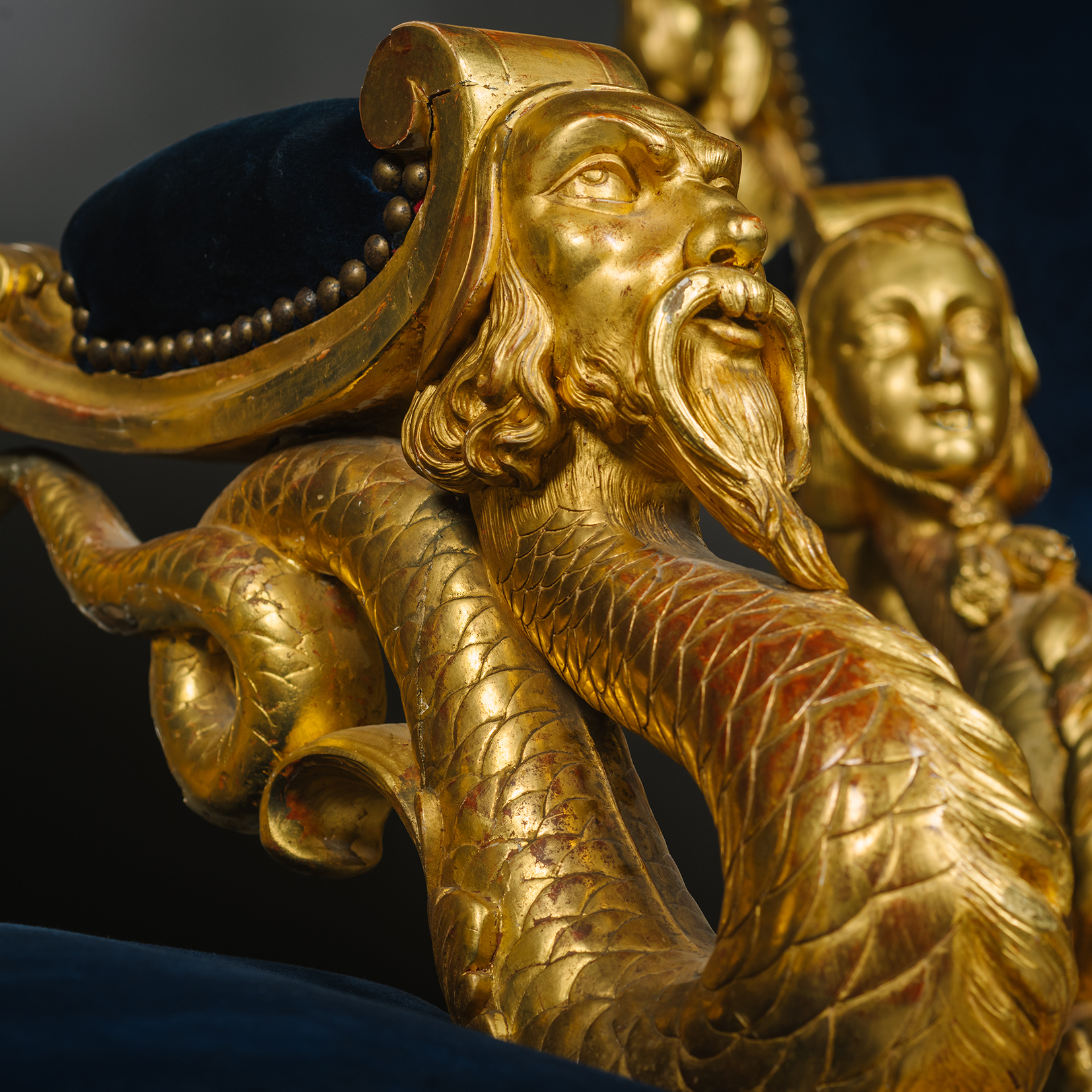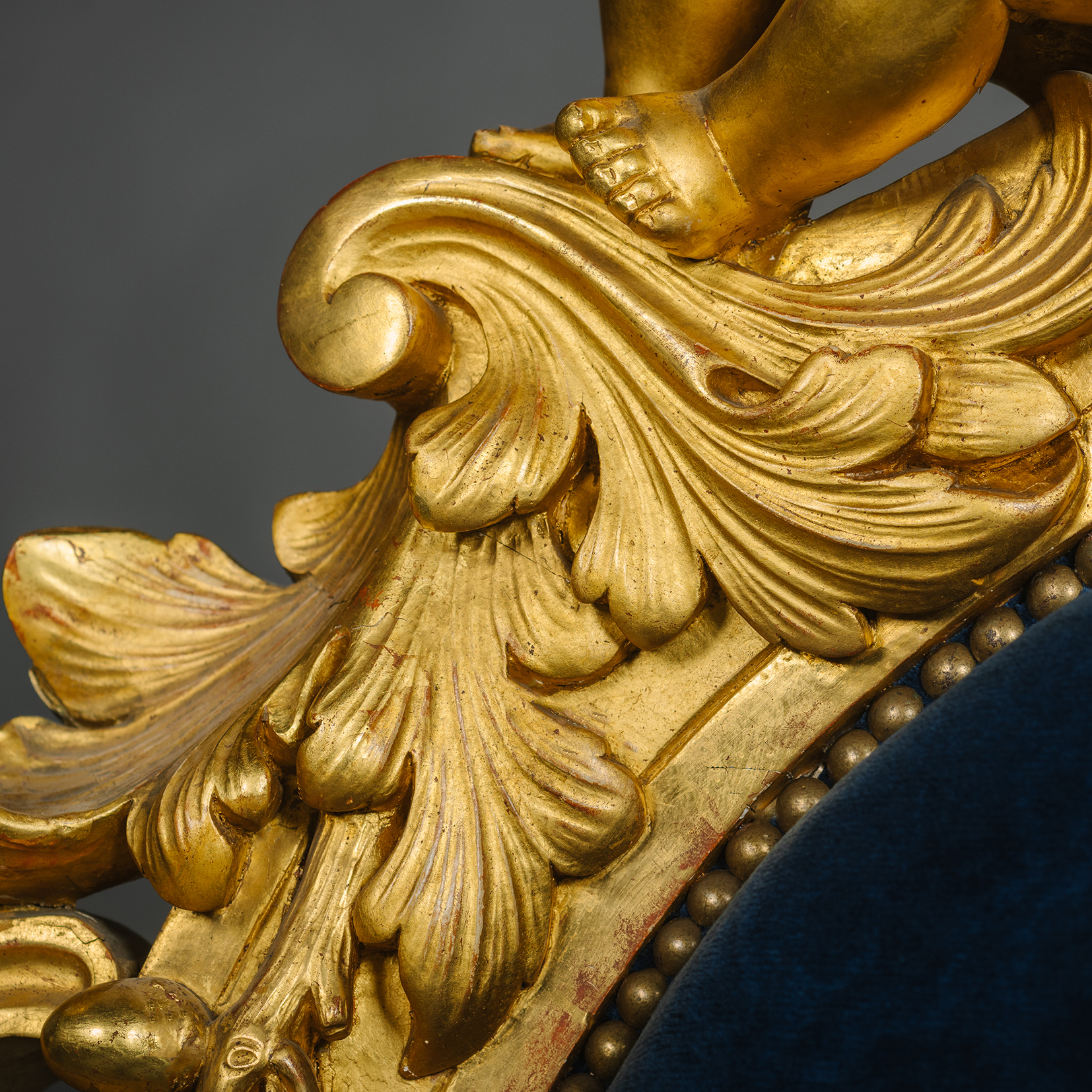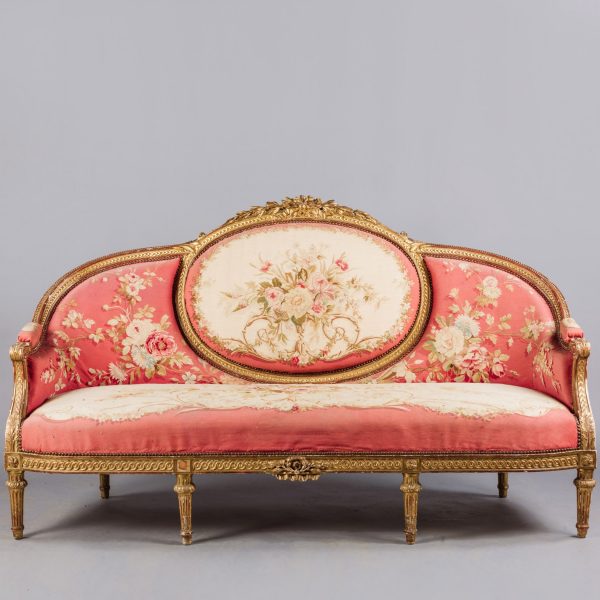A Pair of Magnificent Giltwood Armchairs
£42,000
A Pair of Magnificent Giltwood Armchairs. Each magnificent throne chair with oval padded back encircled by an elaborate cresting carved with flowering...
Dimensions
Height: 133 cm (53 in)Width: 74 cm (30 in)
Depth: 74 cm (30 in)
Description
A Pair of Magnificent Giltwood Armchairs.
Each magnificent throne chair with oval padded back encircled by an elaborate cresting carved with flowering acanthus, oak branches, and fleurs-de-lis. The top rail with two putti holding an armourial star-shaped cartouche with the interlaced L’s of Louis XVIII, King of France, titled ‘Bordeaux 12 Mars 1814’, beneath a crown. This armourial cartouche is the Order of the Armband of Bordeaux.
The open arms with padded armrests above exuberantly carved sculptural terminals depicting dragons with human faces. The shaped seat rail with ribbon and rocaille ornament and to the front with a star representing the Décoration du Lys. On cabriole legs. Upholstered in flower pressed blue velvet.
France, Circa 1820/30.
These magnificent throne chairs commemorate an important event in the Bourbon Restoration precipitating the fall of Napoleon I. They celebrate the surrender of the city of Bordeaux to royal power and to King Louis XVIII (1755-1824), heralding the fall of the first Empire (1804-1815). The Duc d’Angoulême (1775-1844), nephew of Louis XVIII and elder son of Charles X, entered the city of Bordeaux to the acclaim of the crowd on 12th March 1814.
Louis XVIII later called it ‘the happiest event of my life’ and on the 29 September 1820 named the heir to his throne, not—like previous Bourbon heirs—Duc de Bretagne, or de Bourgogne, but the Duc de Bordeaux.
This armourial cartouche to the top rail of these chairs is the Ordre du Brassard de Bordeaux (The Order of the Armband of Bordeaux). It was adopted for the Royal Guard and volunteers who accompanied the Duc d’Angoulême when he entered Bordeaux on 12th March 1814. It was officially called the Brassard de Bordeaux, or Brassard Vert. At first it consisted of a silk band of green with white borders, worn, as the name signifies, on the arm, but was later adapted as a medal with oval gilt sunburst on which is superimposed an oval medallion of white enamel bearing the royal monogram ‘L.L.’, and surrounded by a green enamelled band with the words ‘BORDEAUX 12 MARS 1814’. The whole is surmounted by the royal crown. In 1824 the issue of the Brassard de Bordeaux was controlled by the Royal Order of Legion of Honour and in all a little over one thousand were awarded before it was abolished by King Louis-Philippe in 1831, after which the wearing of the order was outlawed.

The ‘Ordre du Brassard de Bordeaux’ was awarded for the Royal Guard and volunteers who accompanied the Duc d’Angoulême when he entered Bordeaux on 12th March 1814 and began the Bourbon Restoration which would see his uncle crowned King Louis XVIII.
The restoration of the Bourbons was especially welcomed in Bordeaux, which as the first port of France had, until the revolution, been home to many foreign merchants of English and Irish extraction as a prosperous centre of trade with the Caribbean, England and the Baltic. Above and beyond the general disillusionment with the despotic Napoleon, which they shared with many of their countrymen, the history of trading with England made Bordeaux an obvious starting point for the Bourbon restoration. To England’s cost the Napoleonic wars had devastated trade, and for this reason, as much as for sympathy for Louis XVIII exiled in England, the Duc d’Angoulême’s arrival in Bordeaux was orchestrated by the Duke of Wellington. In advance, the French authorities and troops loyal to Napoleon had departed, ensuring Bordeaux’s change of allegiance proceeded without bloodshed, showing that royalism and the desire for peace could be stronger than Napoleon’s type of nationalism.
The prominence to these magnificent chairs of the Brassard de Bordeaux emblem, underscores their importance in commemorating Bordeaux as the fulcrum of the Bourbon restoration as evidenced by the creation of the title Duc de Bordeaux for the heir apparent of the Bourbon monarchy. Their survival is more remarkable given that the order of the Brassard de Bordeaux was repealed by King Louis-Philippe in 1831.
Louis Philippe, of the House of Orléans, a cadet branch of the House of Bourbon, had been subordinated by Louis XVIII. Louis-Philippe himself came to the throne by ignoring the wishes of his cousin Charles X, who had abdicated in favour of his 10-year-old grandson, Henri of Artois, Duke of Bordeaux, Count of Chambord (1820-1883), but prevented from succeeding by Louis Philippe who played his popularity to position himself successfully as the new French citizen king, Louis Philippe I (1773 –1850). Henri of Artois, Duke of Bordeaux, Count of Chambord remained evermore the legitimist pretender to the throne of France, and continued his claim to the throne throughout the July Monarchy of Louis Philippe, the Second Republic and Empire of Napoléon III, and the early years of the Third Republic.
This pair of magnificent armchairs are part of a suite of six, of which each differs in being carved with various flowers and different sculptural terminals depicting assorted anthropomorphic animals and mythological creatures. In the absence of any documentary evidence, it can be speculated that the suite was commissioned by the city of Bordeaux to commemorate the events of 12th March 1814. Another possibility is that they fittingly belonged to the Duc d’Angoulême, or were part of a later Bourbon revival, perhaps commissioned by the Duc de Bordeaux for the colossal Château de Chambord.
The theatrical design of these chairs evidenced by the exuberance of their floral and zoomorphic carved decorations place them stylistically at the intersection of neoclassicism and the Rococo revival apparent in Jean Démosthène Dugoure’s designs for Louis XVIII’s throne room at the Tuileries.

Portrait of Louis XVIII in coronation robes painted in 1822 by Robert Lefèvre (1755–1830).
Date
Circa 1820/1830
Origin
France
Medium
Carved Giltwood
Daniel Alcouffe et al. ‘Un âge d’or des arts décoratifs : 1814-1848’, Catalogue Exposition Galeries Nationales du Grand Palais – Paris – 1991, pp. 74-81.
Philip Mansel, ‘The Return of the Emigrés: Bordeaux, 12 March 1814’, in French Emigrants in Revolutionised Europe, pp. 277-296.



















 Print
Print


